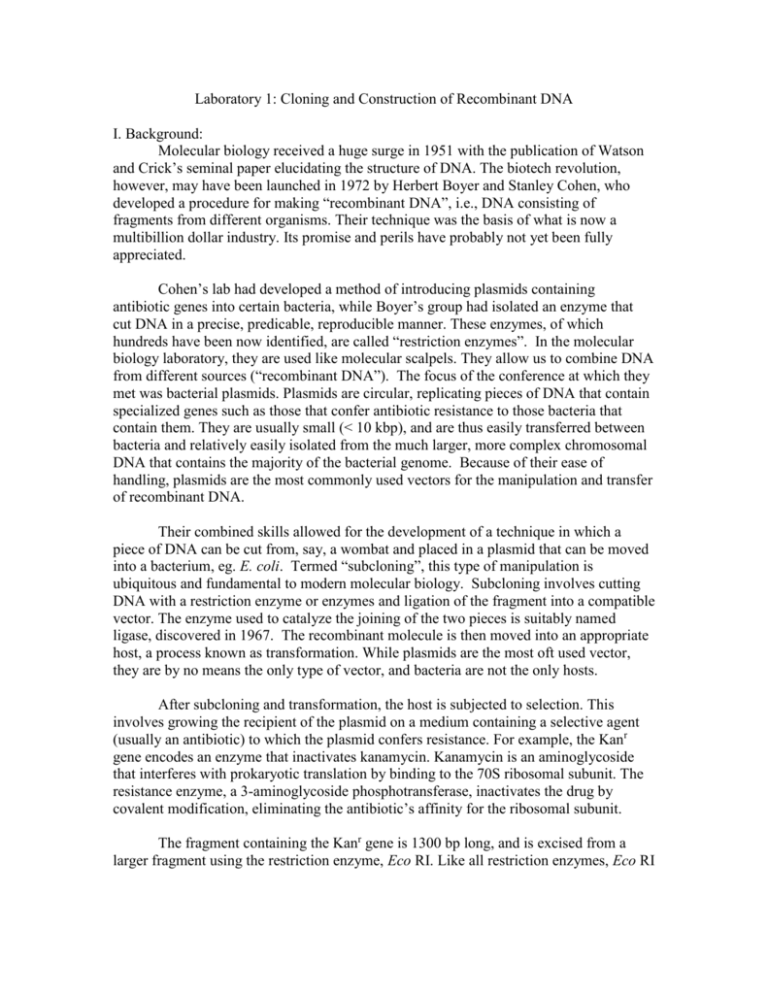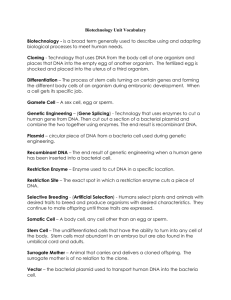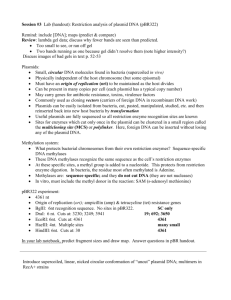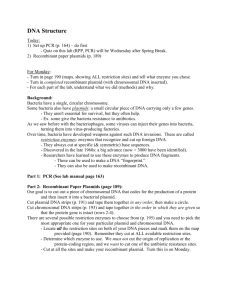Laboratory 1: Cloning and Construction of Recombinant DNA
advertisement

Laboratory 1: Cloning and Construction of Recombinant DNA I. Background: Molecular biology received a huge surge in 1951 with the publication of Watson and Crick’s seminal paper elucidating the structure of DNA. The biotech revolution, however, may have been launched in 1972 by Herbert Boyer and Stanley Cohen, who developed a procedure for making “recombinant DNA”, i.e., DNA consisting of fragments from different organisms. Their technique was the basis of what is now a multibillion dollar industry. Its promise and perils have probably not yet been fully appreciated. Cohen’s lab had developed a method of introducing plasmids containing antibiotic genes into certain bacteria, while Boyer’s group had isolated an enzyme that cut DNA in a precise, predicable, reproducible manner. These enzymes, of which hundreds have been now identified, are called “restriction enzymes”. In the molecular biology laboratory, they are used like molecular scalpels. They allow us to combine DNA from different sources (“recombinant DNA”). The focus of the conference at which they met was bacterial plasmids. Plasmids are circular, replicating pieces of DNA that contain specialized genes such as those that confer antibiotic resistance to those bacteria that contain them. They are usually small (< 10 kbp), and are thus easily transferred between bacteria and relatively easily isolated from the much larger, more complex chromosomal DNA that contains the majority of the bacterial genome. Because of their ease of handling, plasmids are the most commonly used vectors for the manipulation and transfer of recombinant DNA. Their combined skills allowed for the development of a technique in which a piece of DNA can be cut from, say, a wombat and placed in a plasmid that can be moved into a bacterium, eg. E. coli. Termed “subcloning”, this type of manipulation is ubiquitous and fundamental to modern molecular biology. Subcloning involves cutting DNA with a restriction enzyme or enzymes and ligation of the fragment into a compatible vector. The enzyme used to catalyze the joining of the two pieces is suitably named ligase, discovered in 1967. The recombinant molecule is then moved into an appropriate host, a process known as transformation. While plasmids are the most oft used vector, they are by no means the only type of vector, and bacteria are not the only hosts. After subcloning and transformation, the host is subjected to selection. This involves growing the recipient of the plasmid on a medium containing a selective agent (usually an antibiotic) to which the plasmid confers resistance. For example, the Kanr gene encodes an enzyme that inactivates kanamycin. Kanamycin is an aminoglycoside that interferes with prokaryotic translation by binding to the 70S ribosomal subunit. The resistance enzyme, a 3-aminoglycoside phosphotransferase, inactivates the drug by covalent modification, eliminating the antibiotic’s affinity for the ribosomal subunit. The fragment containing the Kanr gene is 1300 bp long, and is excised from a larger fragment using the restriction enzyme, Eco RI. Like all restriction enzymes, Eco RI cuts at a specific recognition site, usually characterized by a palindromic sequence. Eco RI cuts at the following: A map of the resulting fragment is below: Note that the fragments resulting from Eco RI digestion contain unpaired bases on the 5’ end of each strand. Draw it out if you’re not convinced; understanding this is ESSENTIAL!! Thus, these overhangs (“sticky ends”) can base pair with complementary sticky ends from other DNA fragments. Different restriction enzymes leave different ends. There are 3’ overhangs, 5’overhangs, and blunt cutter. Each has its use in the molecular biologist’s toolkit. Below are some examples. For practice, you draw the products of a 6-cutter restriction enzyme that leaves 3’ dinucleotide overhangs. Can you see the advantages of overhangs for routine subcloning? The vector into which we will ligate the Kanr gene fragment is a 3000 bp plasmid, pSP64, derived from the pUC series (plasmid University of California). Like many popular plasmid vectors, pUC vectors have been engineered to contain several unique restriction sites, including a single Eco RI site. The multiple unique sites are clustered in a region of the plasmid called a Multiple Cloning Site (MCS) or polylinker. The polylinker in pUC18 is 44 bp long, containing 13 unique restriction sites. Below is a map of pUC18, showing the restriction sites and other regions of interest. Other noteworthy features of pUC are the lac Z gene, within which the MCS resides, an ampicillin resistance gene (encodes the enzyme -lactamase), and an origin of replication (ori), necessary for replication of the plasmid. What is the plasmid’s shape after cutting with Eco RI? How would the insertion of a 1300 bp fragment affect Lac Z function? After cutting, the fragments need to be ligated together to achieve a recombinant plasmid. Ligase, derived from a bacteriophage, catalyzes the formation of a phosphodiester bond between the 5’ phosphate of one fragment and the 3’hydroxyl of another (below A, B). Complementary base pairing between the sticky overhangs stabilizes the duplex to facilitate the reaction. The reaction requires energy (simplecomplex) in the form of ATP. Because the enzyme is isolated from infected E. coli, the Tm for T4 Ligase is 37˚C, yet ligation reactions are routinely performed at 4˚C to 22˚C. Can you offer an explanation for this apparent inconsistency? Predict the product(s) of the ligation reaction. What are concatamers? How can we increase the percentage of recombinants among the molecular pool? To which end of the polylinker will the Kanr promoter be closest (the 5’ end or the 3’ end)? A. B. Mechanism of Ligase Reaction (E=Enzyme) (from the Biochem 201 site at Stanford University.) NAD ATP When a fragment and vector are cut with a single restriction enzyme, further analysis is required to determine the orientation of the insert. Why? In this laboratory investigation, we will take advantage of a unique Cla I site in the Kanr fragment and a unique Pvu I site that sits 3’ to the MCS in pSP64 (below). By cutting with these two restriction enzymes (a double digest) we can determine the orientation of our insert, an issue that can be of great practical importance. In the diagram above, notice that the ClaI site is ~ 120 bp downstream from an initiator codon (ATG) in the kanr fragment, i.e., it is very close to one end of the insert. The PvuII site is located ~180 bp to the right of the EcoRI site into which the kanr fragment was inserted. By cutting with ClaI and PvuII, we can determine the orientation simply by looking at the size of the fragment released. Do you see why? After the ligation reaction has been performed and verified (how?), the recombinant plasmid is introduced into a suitable host by a process called transformation. There are different ways to introduce foreign DNA into bacteria. One of the simplest, though least efficient, is called chemical transformation. In this procedure, the bacteria are made competent by treatment with CaCl2 or other salts. The mechanism by which cations facilitate uptake is not precisely understood. It may be that they cause the DNA to adhere to the cell wall, increasing the probability of casual uptake. The mechanism whereby heat shock improves uptake is also not completely understood. The bacteria used in this experiment are E.coli strain HB101. This strain has no antibiotic resistance, no plasmids, and lacks restriction enzymes. It also lacks an enzyme, RecA, which is responsible for intracellular recombination. Thus, any plasmid taken up will not be incorporated into the bacterial chromosome. These features are typical of strains used in cloning and subcloning experiments. Once transformed, recombinant cells will make copies of the plasmid, making it easier to generate large amounts of DNA for subsequent manipulations, eg. sequencing. The amount of plasmid required for transformation is extremely small. Typically, 10 ng or less are sufficient. In fact, too much plasmid (>100 ng) can actually reduce transformation efficiency. Several other factors also affect the efficiency of uptake. Linear vectors and large concatamers are not taken up well. Generally, the smaller the plasmid, the more efficiently it is taken up. The uptake event itself is rare; ~ 1 in 10,000 cells will take up exogenous DNA. The number of cells obtained per µg DNA used is called the transformation efficiency. Transformation efficiencies of 105-106/µg are sufficient for most subcloning, but much higher efficiencies, up to 1010/µg, can be obtained using another technique, electroporation. Can you think of a circumstance under which these high efficiencies will be required? The presence of an antibiotic resistance gene on the plasmid allows for easy selection of transformants. Our cells will be plated on agar containing kanamycin. The vast majority of bacteria will die; only those containing a functioning plasmid will survive. Each transformed bacteria will multiply, forming colonies that are easily scored. After transformation, the selective pressure needs to be maintained; otherwise the transformant will eventually be cured of the plasmid. Can you offer an explanation? Single colonies will be transferred to liquid broth containing antibiotic. This will be cultured overnight until the broth is saturated with bacteria. We will extract DNA from bacteria grown in these overnight cultures. Alkaline-lysis plasmid extraction is an old, reliable method for obtaining large amounts of fairly clean, intact plasmid. For many procedures, this DNA can be used as is. For others, eg. sequencing, the plasmid must be further purified. It is important to understand the roles of the various components of the procedure. SDS is a detergent, and will thus dissolve the cell membrane. The procedure begins at a high pH to degrade RNA and aids in protein denaturation. High pH denatures large chromosomal DNA and any linearized or nicked DNA fragments. Plasmid, on the other hand, is a covalently linked circle, so is relatively unaffected by this treatment. The high ionic strength facilitates precipitation of the larger DNA. The supercoiled plasmids remain in solution. Acidified potassium acetate neutralizes the pH, and causes the precipitation of free SDS and the associated SDS/protein/membrane complexes. Chromosomal DNA precipitates with this agglomerate, while the most of the plasmid remains suspended. RNAse is often included to further facilitate the degradation of any contaminating RNA. The supernatant containing the plasmid is usually treated further to remove any contaminating salts, small molecules or proteins. Typically, the super is treated with phenol followed by chloroform. This denatures any proteins, and they are discarded with the organic phase. Treatment with ethanol in the presence of salts (Eg. NaCl, ammonium acetate) causes the plasmid to precipitate while leaving small molecular contaminants in solution. Alternatively, matrices have been developed which selectively remove protein and RNA or selectively bind DNA. These resins have speeded up the purification process. Once you have obtained putative transformants, you will need to definitively confirm transformation by isolating the plasmid and performing restriction analysis. The results will be visualized by agarose gel electrophoresis. You will perform this procedure after the initial ligation and again after transformation. Although size is a major consideration in determining the mobility of DNA in an agarose gel, one must also consider shape and density. Thus, supercoiled plasmid will migrate faster than linearized DNA of the same size. Obviously, nicked concatamers will travel according to their size (i.e., dimers will be lighter, and will thus travel further, than tetramers), By digesting with the appropriate restriction enzymes you will obtain a series of size-separated bands that can be evaluated to determine both the presence of the desired insert and its orientation. How many fragments should you obtain from a digest with EcoRI? PvuI? ClaI? PvuI and ClaI? How can you use these digests to determine the orientation of the insert? Gel electrophoresis is a technique used for the separation of nucleic acids and proteins. Separation of large (macro) molecules depends upon two forces: charge and mass. When a biological sample, such as proteins or DNA, is mixed in a buffer solution and applied to a gel, these two forces act together. The electrical current from one electrode repels the molecules while the other electrode simultaneously attracts the molecules. The frictional force of the gel material acts as a "molecular sieve," separating the molecules by size. During electrophoresis, macromolecules are forced to move through the pores when the electrical current is applied. Their rate of migration through the electric field depends on the strength of the field, size and shape of the molecules, relative hydrophobicity of the samples, and on the ionic strength and temperature of the buffer in which the molecules are moving. After staining, the separated macromolecules in each lane can be seen in a series of bands spread from one end of the gel to the other.







